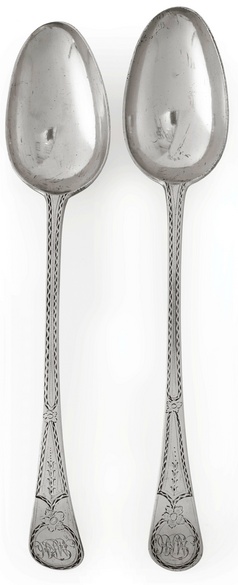 As the holidays approach this fall, chances are you may be hauling out some old silver for serving. We see so much of this at appraisal events – family silver that has been carefully handled for generations, and people expect it to have value. In reality, there are a number of classifications of silver, and while it certainly doesn’t change the sentimental value, it might have little enough monetary value to mean that you could be enjoying it every day rather than just a few days out of the year!
As the holidays approach this fall, chances are you may be hauling out some old silver for serving. We see so much of this at appraisal events – family silver that has been carefully handled for generations, and people expect it to have value. In reality, there are a number of classifications of silver, and while it certainly doesn’t change the sentimental value, it might have little enough monetary value to mean that you could be enjoying it every day rather than just a few days out of the year!
The earliest and generally most valuable types of silver are the three solid forms – Britannia (a temporary British silver standard from 1697 to 1720 which varied from the long-standing sterling standard and was 95.8% silver – in American silver, this would generally be silver made early enough to be based on the British standard and before it was determined to be much too soft for durable use), sterling (92.5% silver), and coin (can be as little as 75%, but can also contain more silver than sterling). Then, around 1743, Sheffield plate was introduced. Early Sheffield plate, while not solid silver, contains significant quantities of silver, as it was constructed by fusing a sheet of silver to a sheet of copper which was then used to make the object. (This Sheffield-plate hot water urn, if you look closely, has wear spots where the underlying copper is visible.) These are the pieces, especially ones made in America, that can command the strongest prices, like the two Paul Revere coin silver spoons (pictured above) that brought almost $105,000.
Over time, the thickness of the silver used became thinner, but the distinction is that early Sheffield is made from a silver plate, while later versions of plating involve making the object in another metal and then plating it. What is often called later Sheffield is really from the early days of electroplating, after the first English patents were granted in 1840 (although it’s worth noting that plating techniques were successfully experimented with in ancient societies). From there, it’s a relatively short slide to modern silver-plate. Electroplating is a process of applying a layer of silver to an inexpensive base metal, usually nickel silver, which isn’t really silver, but a mixture of copper, nickel and zinc, or, more commonly today, stainless steel. Silver-plate thickness, measured in microns, varies – from just 3 microns to 35 microns or more, and over a person’s lifetime, depending on thickness and usage, the plate layer will begin to wear away. (A micron is equivalent to 0.001 millimeter, so we’re talking really thin layers!) Because of the extremely low level of silver content, most silver-plate has little monetary value, even pieces that are “triple-plated,” unless it’s older or of a more elaborate or large-scale form.
Sound complicated? It can be. Decorative pieces are still occasionally made on the Britannia standard. Silver prices fluctuate as the prices for silver bullion, which have historically been very volatile, rise and fall. Early solid silver forms have often been repaired or adapted to suit the changing fashions (like this tankard, made in the mid-18th century, that had the repousse pattern added, quite likely as late as the 20th century), while early Sheffield and electroplated pieces have often been re-plated, but the good thing is that silver is almost always clearly marked, which can help sort things out. Bottom line: if you’ve got some silver socked away, get a sense of what it is, because if it’s not got great monetary value, you can celebrate its sentimental value every day!



